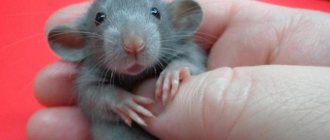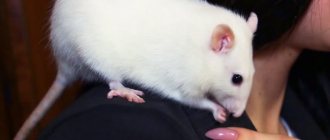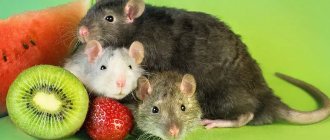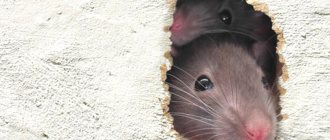One of the most popular pets among many children is the domestic rat. This is a very playful, funny pet that you will never get bored with. However, like any other animal, a rat requires special care, and even more so, feeding. These cute creatures are not whimsical. But there are nuances, which are: walking, huge cages, bathing or combing wool. The main rule is to take care of their proper balanced nutrition, thanks to which they will delight their owners with excellent health and unsurpassed appearance.
Basic principles of feeding
As for food portions, there should be moderation in everything. You should not overfeed a decorative rat, as this can lead to unnecessary excess weight. If your pet leaves a lot of food in the cage, you need to reduce the amount.
Try not to give your rat everything you eat yourself. There are specialized feeds that contain all the necessary components of plant and animal origin.
Considering that these animals are predominantly nocturnal inhabitants, they need the main portion of food in the evening. In general, they are provided with 2 meals a day - morning and evening.
Don't forget to include something hard in your diet so that your rats have the opportunity to wear down their growing teeth.
Scientists' answer
Scientists from the UK were interested in the question of why mice love cheese. They conducted a number of experiments with mammals.
Experience has shown that mice prefer to eat plant foods, and they do not like the smell of cheese at all. Particularly odorous varieties evoke a feeling of danger, and they try to avoid the suspicious object.
An animal living in the wild will eat cereals and fruits, and will only eat other food in case of severe hunger. In the forest or in the field you will not find products created by man. Therefore, it is not surprising that the mammal loves natural food. It looks and smells safe.
Scientists from the British organization Pest Control UK became interested in the results of their colleagues and conducted their own experiment. They used traps with various baits:
- cheese;
- apple;
- chocolate.
The results showed that mice eat cheese. The trap was set with this delicacy, and they liked to run into it the most. But chocolate did not arouse any interest among the animals.
It is likely that the experiment involved different species of mice and different types of treats, which is why the results are so different from each other.
On a note!
Exterminators assure that you should take sunflower seeds, flour, wheat, and unrefined oil as bait. Pests love this kind of food more.
Proper diet for pet rats
In order for your pet to enjoy its good mood and good health for a long time, it is necessary to adhere to the correct diet.
It should contain:
- All kinds of greens - lettuce, parsley, dill, plantain, clover, dandelion leaves, radishes, celery, as well as sprouts of oats, wheat and any other grains.
- Vegetables - boiled potatoes, cabbage, cucumber, turnips.
- Fruits – Introduce any fruit into your pet rat’s food. But you should be careful with citrus fruits, as they can cause allergic reactions.
- Berries are a favorite treat of rodents. Therefore, whatever is at hand is allowed.
- Quail eggs are considered especially healthy, but regular chicken eggs are also suitable.
- Meat. Boiled beef, chicken, pork or turkey will do. It should be given in small pieces.
- Nuts. You can buy everything except almonds. This is because it can cause an allergic reaction.
- Dairy products. These include cottage cheese, kefir, yogurt. Thanks to them, proper intestinal function is established due to lactobacilli and bifidobacteria. However, there are rats that are lactose intolerant. Therefore, you also need to be careful with fermented milk products. To begin, offer a small portion, for example, of cottage cheese, and observe the reaction. If everything is in order, feel free to include this product in your diet.
It is important to understand that greens, fruits and vegetables are the most useful because they contain the maximum amount of vitamins and other essential microelements.
You can also include food sold for cats or dogs in your diet. However, it must be premium. This food consists of animal proteins, therefore it is necessary for the normal growth and development of your pet, as well as to increase its immunity.
Your pet's main daily diet should consist of grains and nuts.
The rest of the above components should be used as an additive or treat.
Fruits
All citrus fruits should be immediately excluded from the diet of rats due to acidity.
. Occasionally you can give a piece of sweet tangerine. Forest and garden berries must be sorted according to their acid level. Thus, cranberries, which are useful in many respects, should be given with caution because of their taste.
Sweet cherries are more suitable than sour cherries. Never give animals seeds from fruit trees or citrus fruits.
They can be poisonous to rodents. You should pay attention to the special properties of fruits. Chokeberry and bird cherry strengthen, and plum weakens. This must be taken into account when choosing food. Pear can cause fermentation in some individuals. Watermelons and melons can be given in small quantities and only in season, as they accumulate nitrates.
Dried fruits are too sweet and may cause fermentation. They should be given carefully, as a treat.
Treats for your pet
Like people, decorative rodents really enjoy their favorite treats. In addition, these cunning animals often manipulate their owners, sitting in front of a full bowl of food with a pitiful look, begging for all sorts of goodies.
However, you should be very careful, since all treats often bring a good mood to your animal, but in too large quantities they are harmful to its health.
You can easily purchase many ready-made treats at any pet store. It is best to choose ones that do not contain flavorings, dyes, as well as sugar and salt. Most rodents love nuts, seeds, various dried fruits, and corn flakes.
Sometimes you can pamper your pet with unsweetened cookies for diabetics, pieces of slightly dried bread, and a minimal amount of chocolate.
For some animals, their favorite treats are pasta, eggs, meat, sausage, in general, everything that you eat yourself. Again, sometimes you can give all this, but always in moderation and infrequently.
Favorite characters
According to another version, perhaps this image was simply well played out by animators and caricaturists who were able to perpetuate this myth for many years. Today it is much easier to imagine and draw a mouse with a delicious slice of cheddar than with a crust of bread and a few grains of rice.
The creators of the popular animated series “Chip 'n' Dale Rescue Rangers” went even further. One of the rescuers is named Rocky, and his full name is Roquefort - in honor of the famous cheese. His father is Charlie Cheder and his mother is Katie Camembert. The main weakness of this daredevil is his incredible love for cheese; from the mere smell he falls into a trance and tries with all his might to get to the coveted piece. But the author’s idea hardly has any connection with reality. Rather, it is a fiction, nothing more.
Nutrition of a decorative rat during illness
Unfortunately, decorative rats, like any other animals, can get sick for some reason. During this period, it is especially important to immediately adjust your diet. What you feed a healthy pet is not always suitable for an animal with a weakened immune system. There are products in nature that will help a rat cope with its illness faster without resorting to medications.
First you need to understand the disease itself. If this is an infection, then mustard, plums, banana, and eggplant can help the rodent. Raspberries, cranberries, garlic and onions are also good to cope with the disease.
If you notice a tumor anywhere on your pet, be sure to add broccoli to its diet. The vitamins found in this vegetable are also useful for the prevention of various neoplasms.
For arthritis, ginger and garlic will best help, but in this case, changing your animal’s diet alone cannot save you; be sure to seek help from a veterinarian so that he can prescribe the correct treatment.
A little history
Who knows where this myth came from.
Most likely, the traces lead to the Middle Ages. Before the invention of the refrigerator, storing food was much more difficult, so everyone got out of the situation as best they could: meat was attached to a hook under the ceiling, grain was kept in bags or barrels, and large circles of cheese were covered with wax or wrapped in linen. In those days, a hungry mouse agreed to eat anything. Meat hanging from the ceiling was harder to get, wheat or cheese was much easier to access. But the loss of several grains from the bag is not so noticeable, and teeth marks are treacherously visible on a piece of cheese. This may have led many to believe that mice love cheese. Even if in fact they only eat it because it turned out to be their only prey.
What to feed rodents during pregnancy
If you are ready to reproduce these beautiful animals, then their body should be properly prepared in advance, and first of all, their nutrition should be adjusted. If your pet has gained excess weight, then get rid of barley, corn, and other foods that contain a lot of calories. Also, do not indulge in foods containing fiber, fats and carbohydrates.
During pregnancy, make sure that your decorative rat receives all the necessary vitamins and beneficial microelements. It is best to include fish and poultry in your diet. To provide the body with minerals, give slaked lime, shell rock and chalk.
Avoid foods such as grapes, cucumbers, liver, onions, lettuce, and eggs during this period.
Where did the statement come from?
Adults are sure that the myth was spread by animators and illustrators of children's publications. But even in ancient times, people believed that small animals love to dine on this aromatic delicacy.
Previously, when there were no poisons and chemicals, the fight against mice consisted of keeping all supplies safely hidden in jugs and cabinets. The exception was cheese. It should have been left uncovered to mature. So the mice had to gnaw it out of hunger.
Animators made the image of an animal with a fragrant treat in its paws very popular. Now many are sure that mice really love cheese.
The main diet of rodents is sweet fruits and cereals. In nature, they build nests in fields where they can easily get grain. The pest's sensitive nose does not tolerate strong aromas and artificial products. Mice do not like cheese and will choose other foods over it if given a choice.
Nutrition of newborn rats
Naturally, immediately after birth, little rat pups feed exclusively on mother's milk. Therefore, it is necessary, first of all, to take care of the mother’s correct diet. After about a month, your pets can be gradually transferred to regular, proper, nutritious food.
There are still cases when, for some reason, a mother cannot feed her baby, so there is no way to do without human help.
You can replace mother's milk with dog or goat milk. If this is not possible, then purchase ready-made mixtures at a pet store and feed the babies according to the scheme given in the instructions.
For the first half month of life, pups need to be fed every 2 hours throughout the day. After this period, the number of feedings should be reduced and done every 4 hours.
During the month, the baby can be gradually switched to adult food. First, introduce your pet to fruits and vegetables. Then add grains to your diet. Don't forget about fermented milk products, which will help normalize intestinal function.
What other fairy tales exist about this?
The next version of mice’s pseudo-love for cheese lies in the shortage of food in the homes of medieval residents.
Like, in those days there was tension with food
. She was sorely missed. There were minimal supplies in the house. As a result, it was difficult to establish the fact that mice were eating food.
Only teeth marks on the cheese served as clear evidence of the presence of mice in the house. This is what this version is based on, explaining the love of mice for cheese.
The next point is related to cartoons. The stereotype of a mouse with a slice of cheese was perpetuated by cartoonists. The rodent looked much better this way
than with some kind of grain.
What to exclude from your diet
We have already figured out what you can feed your rodents, but it is equally important to know which foods are strictly prohibited.
These include:
- raw meat and fish;
- food with all kinds of spices;
- fruit pits;
- raw vegetables;
- alcoholic and carbonated drinks;
- blue cheeses;
- too fatty dairy products;
- leaves of indoor flowers;
- citrus;
- sweets;
- salty food;
- unripe fruits;
- cucumbers, beets, spinach.
We hope this article helped you figure out how to properly feed decorative rats. Despite the fact that these animals are omnivores, you should not feed them just anything, as this can lead to serious health problems.
By adhering to simple rules regarding the diet of your pets, you will be able to admire for a long time how they grow and enjoy life.
Do not forget that the main component of the diet is grains and vegetables. However, for proper nutrition, animals also need animal proteins, fermented milk products, fruits and a variety of greens.
Food preferences
Every pet rat has its own favorite treat. Some animals prefer insects. They can be given mealworms, which can be purchased at your local pet store. Other rats love to eat sweets. They should not be abused, because... they are high in calories. It is better to use treats as a reward during the training process. They can also be given after medical procedures or during periods of illness. A tasty treat should be safe for your pet. Apples are suitable as a treat. It is forbidden to feed the rodent smoked sausages, alcohol, chocolate, carbonated drinks, canned goods and leaves of indoor plants.
Types of cheese
Cheese can be classified according to the following criteria:
- Type of milk used - cow, sheep, goat or buffalo;
- Fat percentage – low, medium, high and very high;
- Consistency – soft, semi-solid and hard.
There are many types of cheese you can feed your rat. Try to avoid high-fat cheeses, as well as cheeses containing all kinds of herbs, seasonings and molds. Give preference to regular low-fat cheeses without additives.
Conclusion
Mice are vegetarians. They will eat seeds, vegetables and fruits faster than cheese. But this does not mean that mice will ignore the product in question. If there is nothing suitable, these rodents will eat anything, including cheese.
Sources
- https://FB.ru/post/nature/2018/6/19/27023
- https://zen.yandex.com/media/factusios/myshi-i-syr-pravda-li-chto-pervye-tak-liubiat-vtoroe-ili-eto-vrane-5e24a5eb32335400ac8d97ac
- https://apest.ru/myshi/vse-o-myshah/edyat-li-myshi-syr/
- https://klause.ru/gryzuny/lyubyat-li-myshi-syr.html
- https://KOTiKo.ru/krysy/pitanie-krys/mozhno-li-krysam-syr-moloko-tvorog-i-drugie-molochnye-produkty.html
- https://likehamster.ru/domashnie-krysy/pitanie-krys/molochnye-produkty-krysam/
- https://zen.yandex.ru/media/id/5ca4d38ad92e0900b447a942/chem-mojno-kormit-krysu-a-ot-chego-luchshe-otkazatsia-5ce80e1fb2297700b54b7f45
- https://homkin.ru/krysy/pitanie-krys/mozhno-li-krysam-syr-i-moloko.html
[collapse]
Can I have milk?
Milk is very healthy; in addition to calcium, it contains vitamins A, D, E, and many microelements. But you should always remember that the human body is structured differently from that of animals.
A rat can have milk, but it should not be included in the daily menu. This product can cause digestive upset in rodents, so it can be given no more than 2-3 times a week and in small quantities.
In addition, remember that milk is a complete food and cannot be used as a drink; the rat must always have clean water, which changes regularly.











